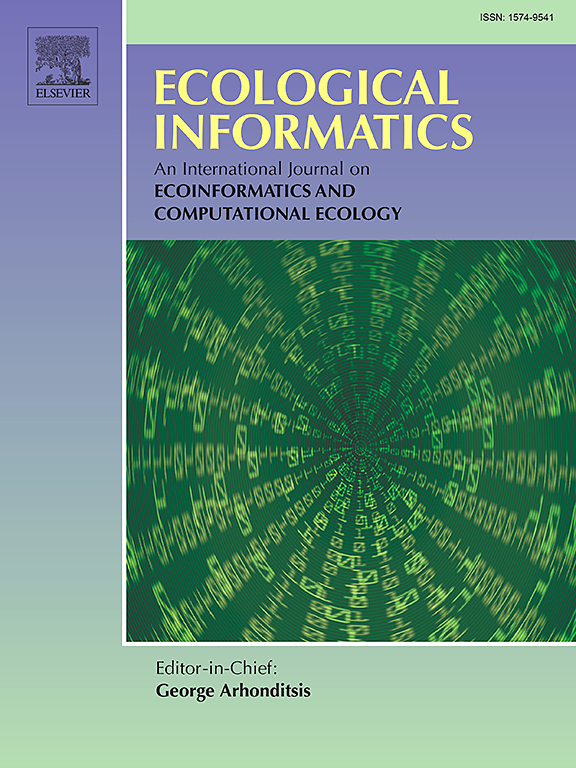Improving AI performance in wildlife monitoring through species and environment-specific training: A case study on desert Bighorn sheep
IF 5.8
2区 环境科学与生态学
Q1 ECOLOGY
引用次数: 0
Abstract
Motion-activated cameras are widely used to monitor wildlife, offering a non-intrusive and cost-effective means to collect high volumes of data. Artificial intelligence (AI) models can expedite image processing, but automated species classifications can be too inaccurate to meet end-users' needs. This study evaluates how selection of data for model training influences AI detection of a focal species (desert bighorn sheep; Ovis canadensis nelsoni) across similar and novel locations. We compared two AI models: a species-specialist (deep_sheep) and a species-generalist (CameraTrapDetectoR), identified sources of bias, and retrained the specialist model using two datasets targeted toward biases associated with classification failure. Testing on 95,547 images from 36 water sources (5 novel) in the Mojave and Sonoran Deserts revealed the specialist model outperformed the generalist by 21.44 % in accuracy and reduced false negatives by 45.18 %. The specialist model was retrained first on site-representative data, then on both site-representative and extreme image-condition data. Retraining iterations consecutively reduced the false negative rate (36.94 % → 6.23 % → 4.67 %) and improved reliability across sites at the cost of a reciprocal increase in false positive rate (2.87 % → 15.22 % → 23.97 %) and variation. The site-representative retraining had the highest overall accuracy. Accuracy at out-of-sample sites remained comparable to the full dataset, though minor performance declines were observed. We found that specifying an AI's training to single-species classification and conditions within specific environments produced robust classification accuracy at minimal data requirements. By narrowing objectives while ensuring adequate training data variety, we achieved 89.33 % accuracy with a small fraction of the training data required by similar performing models.
通过特定物种和环境的训练提高人工智能在野生动物监测中的表现:以沙漠大角羊为例
运动激活相机被广泛用于监测野生动物,为收集大量数据提供了一种非侵入性和经济有效的方法。人工智能(AI)模型可以加快图像处理,但自动物种分类可能太不准确,无法满足最终用户的需求。本研究评估了模型训练数据的选择如何影响焦点物种(沙漠大角羊;在相似和新颖的地点。我们比较了两个人工智能模型:一个物种专家(deep_sheep)和一个物种通才(CameraTrapDetectoR),确定了偏差的来源,并使用两个针对与分类失败相关的偏差的数据集重新训练了专家模型。对来自莫哈韦沙漠和索诺兰沙漠36个水源(5个新水源)的95,547幅图像的测试显示,专家模型的准确率比通才模型高21.44%,假阴性率降低45.18%。专家模型首先在站点代表性数据上进行再训练,然后在站点代表性和极端图像条件数据上进行再训练。再训练迭代连续降低了假阴性率(36.94%→6.23%→4.67%),并以假阳性率(2.87%→15.22%→23.97%)和变异的互增为代价提高了跨站点的可靠性。现场代表再培训的总体准确性最高。样本外站点的准确性仍然与完整数据集相当,尽管观察到轻微的性能下降。我们发现,将人工智能的训练指定为单物种分类和特定环境中的条件,可以在最小的数据要求下产生强大的分类准确性。通过缩小目标,同时确保足够的训练数据多样性,我们使用类似执行模型所需的一小部分训练数据实现了89.33%的准确率。
本文章由计算机程序翻译,如有差异,请以英文原文为准。
求助全文
约1分钟内获得全文
求助全文
来源期刊

Ecological Informatics
环境科学-生态学
CiteScore
8.30
自引率
11.80%
发文量
346
审稿时长
46 days
期刊介绍:
The journal Ecological Informatics is devoted to the publication of high quality, peer-reviewed articles on all aspects of computational ecology, data science and biogeography. The scope of the journal takes into account the data-intensive nature of ecology, the growing capacity of information technology to access, harness and leverage complex data as well as the critical need for informing sustainable management in view of global environmental and climate change.
The nature of the journal is interdisciplinary at the crossover between ecology and informatics. It focuses on novel concepts and techniques for image- and genome-based monitoring and interpretation, sensor- and multimedia-based data acquisition, internet-based data archiving and sharing, data assimilation, modelling and prediction of ecological data.
 求助内容:
求助内容: 应助结果提醒方式:
应助结果提醒方式:


